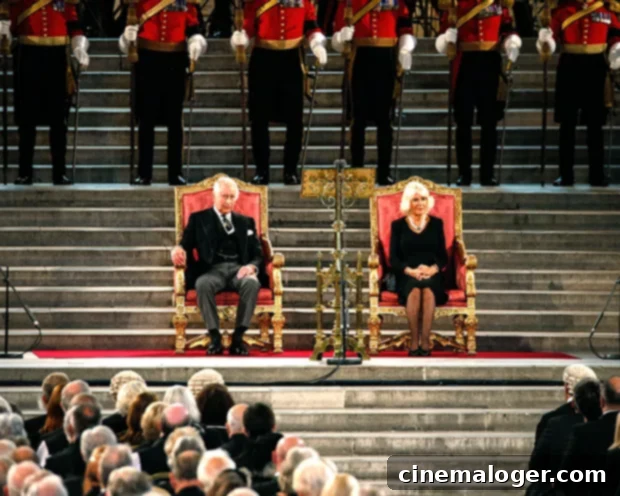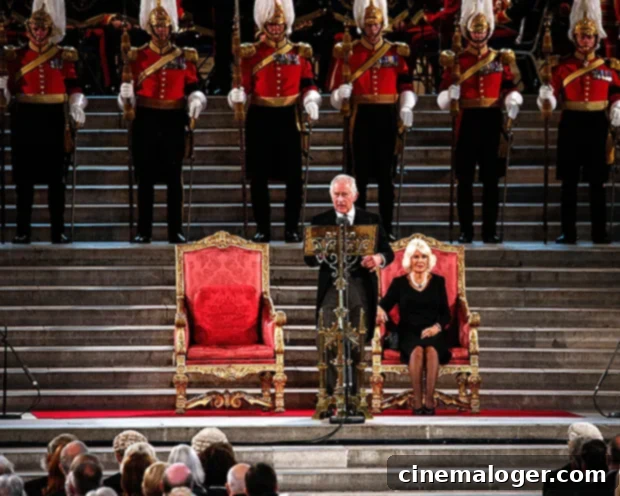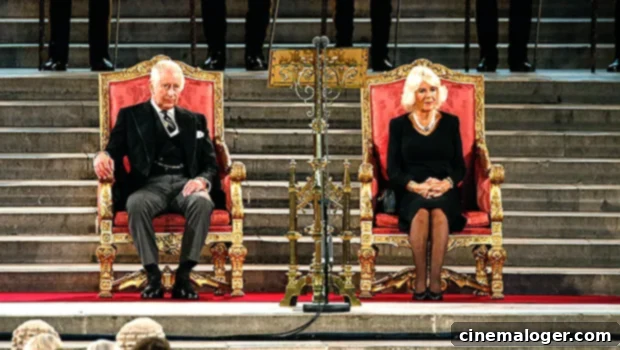King Charles III Ascends the Throne: A New Era Dawns for the British Monarchy After Queen Elizabeth II’s Profound Legacy
The British monarchy embarked upon a pivotal new chapter with the ascension of King Charles III. Following the profound loss of Queen Elizabeth II, a monarch who reigned for an unprecedented 70 years, her eldest son, Charles, automatically became king. This historic transition was formally marked by a series of deeply symbolic events, ushering in a new reign that promises both continuity and subtle evolution. The world watched as the United Kingdom, steeped in centuries of royal tradition, navigated this significant moment of succession, mourning a beloved Queen while welcoming a new King.
On a somber yet significant Monday (September 12), Britons witnessed a moment of profound historical weight as King Charles III took his place on the throne for the first time since the passing of his revered mother, Queen Elizabeth II. This poignant occasion saw the 73-year-old monarch seated alongside his wife, Camilla, Queen Consort, symbolizing the dawn of their joint reign. The royal couple received 900 esteemed members of the legislative body, including representatives from both the House of Commons and the House of Lords. Each expressed their heartfelt condolences and unwavering support following the queen’s peaceful passing on September 8th. King Charles, visibly moved, conveyed his deep gratitude for the outpouring of national and international support. He also solemnly pledged his unwavering commitment to upholding the country’s cherished constitutional monarchical principles, a pledge reported widely by outlets like PEOPLE, reaffirming his dedication to the enduring framework of British governance.

Embracing the Weight of History: King Charles III’s Solemn Vow
Addressing the assembled dignitaries, King Charles III articulated the profound sense of responsibility he now carried, stating, “I cannot help but feel the weight of history, which surrounds us.” He eloquently recalled his mother’s early commitment to duty, emphasizing, “While very young, her late Majesty pledged herself to serve her country and her people and to maintain the precious principles of constitutional government which lie at the heart of our nation.” The new monarch then paid tribute to Queen Elizabeth II’s unparalleled devotion, affirming, “This vow, she kept with unsurpassed devotion. She set an example of selfless duty which with God’s help and your counsels I am resolved faithfully to follow.” This statement underscored his dedication to continuing the legacy of unwavering service, a cornerstone of the British Royal Family’s ethos. His words resonated deeply, connecting his nascent reign directly to the illustrious and enduring reign of his mother, ensuring a sense of continuity and stability during a period of national mourning and transition.
The ceremony itself was rich with symbolism, a vivid display of the ancient traditions that underpin the modern British state. King Charles III’s appearance before Parliament, an independent institution, highlighted the unique relationship between the Crown and the legislative body. This delicate balance is fundamental to the constitutional monarchy, where the monarch reigns but does not rule, acting as a head of state above political fray. His presence in Westminster Hall, a site steeped in over a thousand years of British history, served as a powerful reminder of the enduring nature of the monarchy and its crucial role as a unifying national symbol. The formal exchange of condolences and commitments marked not just a personal moment for the King, but a national affirmation of the constitutional order.

A New Anthem and a Mourning Journey for the United Kingdom
A particularly moving moment occurred when England’s national anthem, now “God Save The King,” was sung in the sovereign’s presence for the very first time. King Charles was visibly emotional, a human reaction underscoring the profound personal and public transformation he was undergoing. This powerful rendition marked a significant symbolic shift, signifying the official start of a new royal era and the collective recognition of the new monarch. Following these initial duties, King Charles embarked on a poignant four-nation mourning tour, an essential part of the somber proceedings. This tour, encompassing England, Scotland, Wales, and Northern Ireland, was designed to allow him to connect with his diverse subjects, receive their condolences, and share in the collective grief of the nation. It also served as a respectful journey accompanying the Queen’s final passage towards her dignified resting place in Windsor Castle, a sacred site deeply intertwined with royal history and tradition.
The tour was more than just a series of ceremonial visits; it was a carefully choreographed expression of unity and national mourning. In each capital, the King participated in services of remembrance and met with political and religious leaders, as well as members of the public. These interactions provided an opportunity for the new monarch to demonstrate his accessibility and empathy, reinforcing the monarchy’s role as a symbol of stability and continuity during a period of immense change. The sight of King Charles III engaging with people across the United Kingdom helped to solidify his position as the new head of state and assured the public of the monarchy’s enduring relevance in modern British society. The tour, therefore, played a crucial role in both honoring the past and shaping the future of the British crown.
A Son’s Heartfelt Tribute: King Charles III’s First Public Address
In his inaugural speech as King, delivered shortly after his mother’s death, Charles offered a deeply personal and touching tribute to Queen Elizabeth II. He spoke with raw emotion, acknowledging the immense void left by her passing at the age of 96. “Throughout her life, Her Majesty, the Queen, my beloved mother was an inspiration to all my family, and we owe her the most heartfelt debt any family can owe to their mother for her love, affection, guidance, understanding, and example,” he articulated, his voice imbued with sorrow and reverence. He celebrated her extraordinary life, declaring, “Queen Elizabeth’s was a life well lived, a promise with Destiny kept, and she is mourned most deeply in her passing.” These words encapsulated the national sentiment, acknowledging not just a monarch, but a matriarch whose influence extended far beyond the royal family to touch the lives of millions globally. His speech was a masterclass in conveying both personal grief and regal responsibility, setting a tone of continuity and heartfelt duty for his upcoming reign.
The King’s heartfelt address resonated powerfully with a nation in mourning. It provided comfort and solace, assuring the public that while the monarch had changed, the values and principles embodied by Queen Elizabeth II would endure. His recognition of her “promise with Destiny kept” was particularly poignant, highlighting her unwavering commitment to her coronation oath and her lifelong service. This initial speech was crucial in shaping public perception of the new King, showcasing his eloquence, sincerity, and deep respect for his mother’s legacy. It was a moment where the personal sorrow of a son merged with the solemn duty of a sovereign, marking the beginning of his public journey as King Charles III.
A Fond Farewell: King Charles III’s Moving Closing Remarks
Concluding his deeply moving first address to the British public as their new sovereign, King Charles offered a tender, final farewell to his beloved mother. “To my darling Mama, as you begin your last great journey to join my dear Papa. I want simply to say this: thank you,” he expressed, his voice tinged with both grief and profound gratitude. He continued, acknowledging her unparalleled dedication: “Your love and devotion to our family and to the family of nations you have served so diligently all these years. May flights of angels sing thee to thy rest.” This poetic and deeply personal closing statement, echoing Shakespearean sentiment, provided a poignant end to a speech that was both a eulogy and a declaration of intent. It allowed the public to share in his personal grief while also witnessing the strength and grace with which he was preparing to embrace his new role as the head of state and head of the Commonwealth. It was a moment of profound intimacy shared with a grieving nation, solidifying his image as a compassionate and dutiful leader.
This particular segment of his speech was widely praised for its emotional depth and its ability to connect on a human level. It demonstrated King Charles III’s capacity for vulnerability alongside his commitment to his royal duties. The phrase “family of nations,” referring to the Commonwealth, underscored the global reach of Queen Elizabeth II’s influence and the significant international role the British monarchy continues to play. By invoking such a tender personal farewell, the King created a bridge between the intensely personal loss he experienced and the collective grief of the nation and the wider Commonwealth, reaffirming the enduring emotional bond between the monarch and their subjects.
Navigating Family Dynamics and The Future: New Royal Roles
During his momentous speech, King Charles III also addressed the evolving dynamics within the Royal Family, extending an olive branch and expressing his love for both Prince Harry and his wife, Meghan Markle, as they “continue to build their lives overseas.” This public acknowledgment was seen as a significant gesture of reconciliation and familial warmth amidst ongoing speculation about their relationship with the monarchy. Simultaneously, he formally bestowed crucial new titles upon Prince William and his wife, Kate Middleton, christening them as the new Prince and Princess of Wales. This investiture is a pivotal moment, marking William’s clear position as the heir apparent and highlighting Kate’s elevated and increasingly visible role within the Royal Family. The King expressed profound confidence in his eldest son, stating, “I know [William will] continue to inspire and lead our national conversations, helping to bring the marginal to the center ground where vital help can be given.” This statement not only outlined William’s future responsibilities but also subtly indicated a desire for a modern, engaged monarchy that actively addresses contemporary societal issues, signaling a progressive approach under King Charles III’s reign.
The appointment of William and Kate as Prince and Princess of Wales carries immense historical and symbolic weight. The title of Prince of Wales is traditionally held by the heir apparent to the British throne, signifying his direct line of succession. Kate, as Princess of Wales, steps into a role previously held by Princess Diana, a figure who captivated the nation and the world. This new status elevates their public profile and responsibility, positioning them as key figures in the future of the monarchy. Their work, focusing on areas like mental health, early childhood development, and environmental issues, is expected to continue to evolve, reflecting the King’s vision for a relevant and impactful Royal Family. The King’s explicit mention of William’s ability to “bring the marginal to the center ground” suggests a monarchy keen on engaging with diverse perspectives and addressing pressing social concerns, moving beyond purely ceremonial duties.
The Role of Camilla, Queen Consort: A Steady Presence
Alongside King Charles III, Camilla, Queen Consort, has also taken on a significantly elevated role. Her journey to becoming Queen Consort has been a long and often scrutinized one, yet she has consistently proven to be a steadfast and supportive partner to Charles. Her presence on the throne during the parliamentary address, and her dignified demeanor throughout the period of mourning, have underscored her commitment to the Crown and her ability to provide quiet strength to the new King. She has embraced various charitable endeavors over the years, often focusing on literacy, domestic abuse, and osteoporosis, bringing a gentle yet firm dedication to her public duties. Her role as Queen Consort is not merely ceremonial; she is expected to support the King in his duties, represent the monarchy, and continue her own charitable work, contributing to the monarchy’s charitable footprint and public engagement.
The transition of Camilla from Duchess of Cornwall to Queen Consort signifies the complete acceptance of her role within the Royal Family and by the public. Queen Elizabeth II herself expressed her “sincere wish” that Camilla would be known as Queen Consort, a powerful endorsement that paved the way for this seamless transition. Her quiet resilience and dedication to Charles have been central to her public image, and as Queen Consort, she is poised to play an increasingly visible and supportive role. This includes attending state functions, receiving dignitaries, and participating in various engagements, all while providing an essential bedrock of personal support to King Charles III as he embarks on his new, demanding responsibilities.
Challenges and the Vision for a Modern Monarchy
King Charles III inherits a monarchy that, while deeply respected, faces the ongoing challenge of remaining relevant in a rapidly changing world. His reign is anticipated to be one of careful modernization, balancing the weight of tradition with the demands of contemporary society. Having been the longest-serving heir apparent in British history, Charles has had ample time to reflect on the future of the institution. He has often expressed strong views on issues such as environmental conservation, sustainable architecture, and interfaith dialogue, suggesting that his reign may see a more vocal and engaged monarch on certain topics, albeit within the bounds of constitutional impartiality. The vision for his reign includes strengthening the Commonwealth, fostering unity within the United Kingdom’s diverse communities, and promoting environmental awareness—causes he has championed for decades.
The public’s perception of the monarchy will undoubtedly evolve under King Charles III. He steps into shoes left by a mother whose popularity was immense and whose reign provided unparalleled stability. The King will need to carefully navigate public expectations, maintaining the dignity and tradition of the Crown while demonstrating its capacity for adaptation and empathy. His commitment to serving the people, as evidenced in his first speeches, forms the bedrock of his approach. The challenges will include managing ongoing discussions about the monarchy’s role in the 21st century, addressing issues of historical legacy, and ensuring the institution remains a source of national pride and unity. As the United Kingdom and the Commonwealth move forward, King Charles III’s reign will be a testament to the enduring power of monarchy, adapted for a new era.
